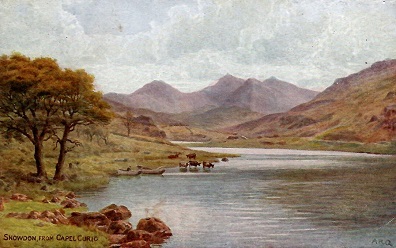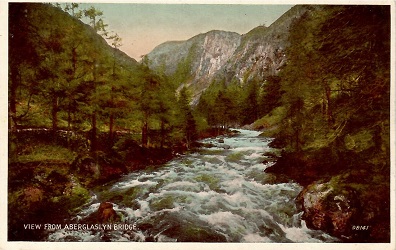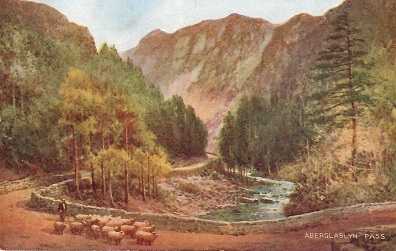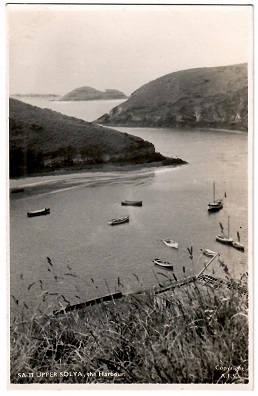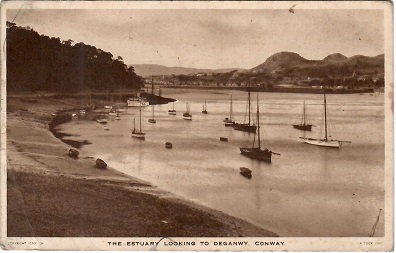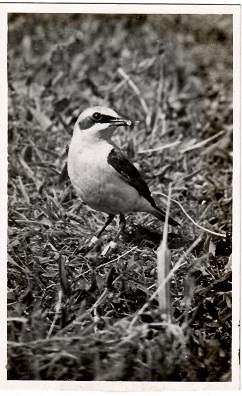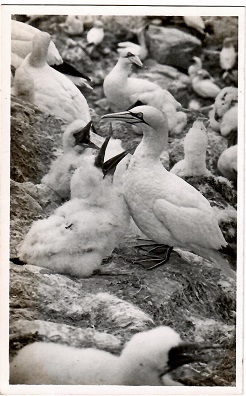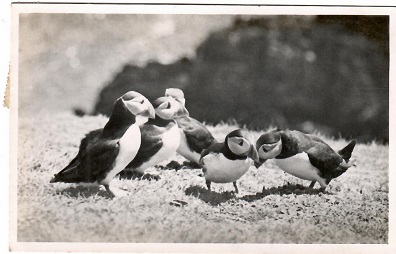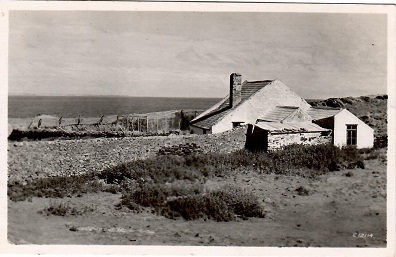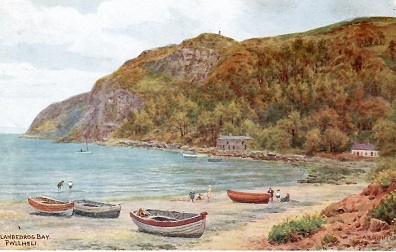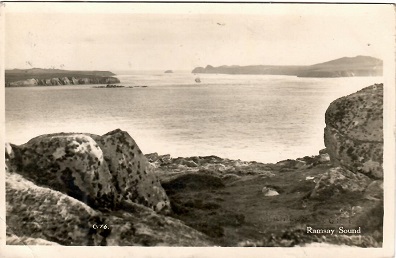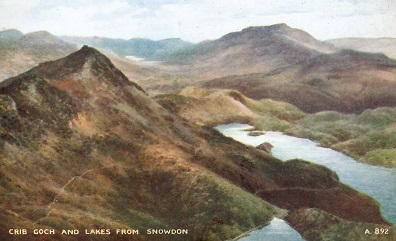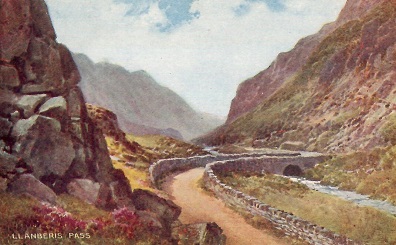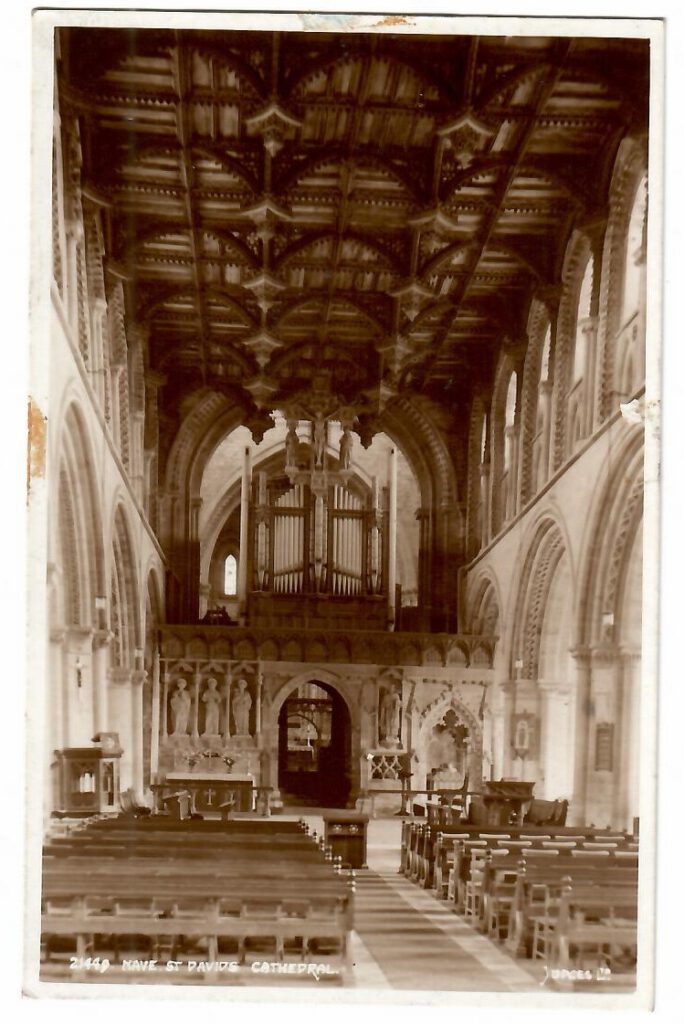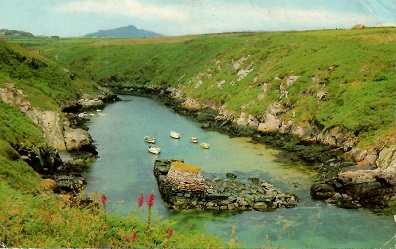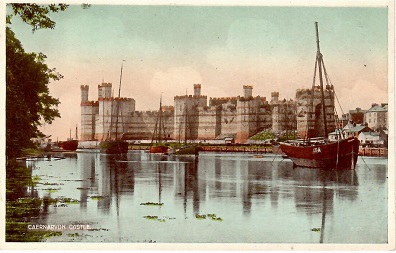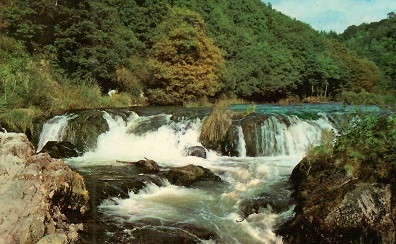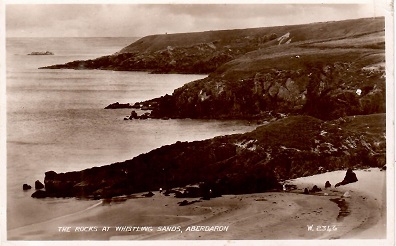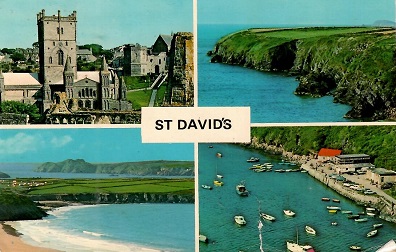-
Snowdon from Capel Curig
Capel Curig takes its name from St. Julitta’s Church in the ancient graveyard by the river bridge on the Llanberis road. Tradition claims this chapel to be the 6th-century foundation of St Curig, a Celtic bishop. Centuries later, probably when the present ancient church was built, the name appears to have been Latinised as Cyricus, which is the name of a 4th-century child martyr whose mother was Julitta. They are usually named together as Saints Quiricus and Julietta. Does that help explain? This is unused J. Salmon card *1037, showing its age but still clean enough for Grade: 1
-
View from Aberglaslyn Bridge
Unused Valentine’s card 98141. Grade: 1
-
Aberglaslyn Pass
Unused Valentine’s card A153. Grade: 1
-
Upper Solva, The Harbour
Smaller places we don’t know often have rich histories. Wikipedia tells us that the rocks at the entrance to Solva Harbour made it one of the most sheltered anchorages between Fishguard and Milford Haven; it was marked on a 1578 parish map as Dolvath Haven. On a 1748 map it is named Solvach. Solva became the main trading centre of St Bride’s Bay in the medieval period, and was important for lime burning. By the end of the 18th century Solva had begun to expand, and could accommodate vessels of 500 tons, or up to 1,000 in an emergency… The fading coastal trade was replaced by tourism, and the harbour became a leisure boating centre. The village was the location for Wales’s first butterfly farm, Solva Nectarium, which opened in 1979, long after this postcard came out. It’s Frith’s Series SA-37, real-photo, and a small bit of age foxing on the reverse. Grade: 1.
-
Conway (sic) Castle and Bridge
Conwy Castle was built by Edward I during his conquest of Wales, between 1283 and 1287. Constructed as part of a wider project to create the walled town of Conwy, over the next few centuries the castle played an important part in several wars. It withstood the siege of Madog ap Llywelyn in the winter of 1294–95, acted as a temporary haven for Richard II in 1399 and was held for several months by forces loyal to Owain Glyndŵr in 1401. So you can see it from your armchair on this B&W real-photo Valentine’s card 5610, mailed in the early 1950s with 2d stamp and postmark. It’s been handled over these many years but all is intact and clean enough. Grade: 1
-
Conway, The Estuary Looking to Deganwy
The correct name at one time was “Conway” but now “Conwy” derives from the old Welsh words cyn (chief) and gwy (water), the river being originally called the ‘Cynwy’. This old sepia Tuck’s Post Card CNY 24 was mailed in 1951. The 2d stamp and postmark are there. The card has been well-loved and handled over the years, adding to character. Grade: 2
-
Pembrokeshire, Skokholm Island Bird Observatory and “Heligoland” Trap
In 1933, Skokholm began as a bird observatory, the first in Britain, founded by Ronald Lockley; its prime function was the ringing of wild birds and research. Lockley started the Pembrokeshire Bird Protection Society in 1938, now incorporated in the Wildlife Trust of South and West Wales. In 1948 the West Wales Field Society (WWFC), also now Wildlife Trust of South and West Wales, first took the Lease of Skokholm from the owners of the Dale Castle Estate. Ringing on Skokholm ceased from 1976, and during the period of radar studies of migration around 1960 it became clear that bird movements as observed at the observatories were not representative of the whole, so significance of observatories in the study of migration waned. Skokholm had been the site of the most thorough British studies of the European storm petrel and razorbill amongst the seabirds and the Eurasian oystercatcher and the northern wheatear amongst the landbirds. Skokholm Island was re-accredited as a bird observatory in 2014. We thank Wikipedia for that, which sets the stage for this and a few following postcards. Here is an unused real-photo card, and you may be excused if you wonder where the observatory is. Grade: 1
-
Skokholm Island, Adult Wheatear at nest
Unused real-photo card from the Observatory. Grade: 1
-
Skokholm Island, Adult and Nesting Gannet
Unused real-photo card from the Observatory. Grade: 1
-
Skokholm Island, Puffins “billing” in Crab Bay
Unlike other cards in this short series, this one was mailed, in 1952, with four stamps and the postmark. Two stamps overlap each other, and two were cancelled by marker when the postmark didn’t reach them. Otherwise, all is well. Grade: 3
-
Skokholm Island, Adult Oystercatcher with nestling and egg
Unused real-photo card from the Observatory. Grade: 1
-
Skokholm Island, The house and the garden trap
Unused real-photo card from the Observatory. Grade: 1
-
Caerfai Bay
Don’t jump! Mailed maybe in the 1990s, the postmark is not distinct, however the 26p and blue airmail label are there, along with a thumbtack hole near the top. Grade: 5
-
Carnarvon Castle
Unused, Salmon Series card *3152. Grade: 1
-
St. Davids Cathedral from South West
Mailed in the 1950s with 3d stamp and partly readable postmark. It’s Valentine’s card 16274. Grade: 1
-
Pwllheli, Llanbedrog Bay
Unused J. Salmon card *3148. Grade: 1
-
Ramsay (sic) Sound
Either the card got it wrong or the location has changed its spelling from Ramsay Sound to Ramsey Sound now. Either way, what we have here is a real-photo “local” card mailed in 1959 with stamp and unusually clear postmark. A very slight, not-disfiguring stain in the message area. Grade: 1
-
Crib Goch and Lakes from Snowdon
Here is more than you might want to know about mountaineering, and it comes (condensed) from Wikipedia: “Crib Goch is described as a ‘knife-edged’ arête in the Snowdonia National Park … the name means “red ridge” in Welsh. The highest point 923 metres (3,028 ft) above sea level. All routes which tackle Crib Goch are considered mountaineering routes in winter or scrambles in summer—meaning that they must cross graded territory as defined in Steve Ashton’s Scrambles in Snowdonia. The easiest of these lines (the ‘bad step’ part of the route) is given a scrambling grade of Grade 1 (the most difficult being Grade 3—routes more difficult than Grade 3 are considered rock climbs).” Anyhow, all that relates to this unused Valentine’s card A892. Minor foxing on the reverse. Grade: 1
-
Llanberis Pass
Unused Valentine’s card A154. Grade: 1
-
St. Davids Cathedral, Nave
Judges’ Ltd. card 21449, mailed in 1959 with 3d stamp and clear postmark. Grade: 1
-
Near St. Davids, Porthclais Harbour
From the Visit Pembrokeshire website (condensed): “This is a popular spot for launching canoes … The beach is shingle so it isn’t a bathing beach, but a good place for starting or finishing a walk on the coast path. Just east of the harbour is the most popular slab for practising rock climbing. If you’re planning to visit, check out the tide times to make sure you’ve plenty of beach to play on and that you don’t get cut off by the incoming tide!” That website has a great photo taken from exactly the same location as the view from this old card, which has a 26p stamp but no postmark. Maybe 1980s? Grade: 3
-
Caernarvon Castle
Unused Valentine’s “Carbo Colour” card. Grade: 1
-
Cenarth, Salmon Leap Falls
Mailed in 1979, the card has a 20p stamp, blue airmail label, and Cardigan postmark. (We can’t resist hoping there really are salmon in the river.) Grade: 1
-
Aberdaron, The Rocks at Whistling Sands
Mailed in 1951 with 2d stamp and full postmark. It’s Valentine’s real-photo postcard W.2346. The Visit Snowdonia website makes this sound quite remote: “Land’s end at its most idyllic. This fishing village was the last stop for pilgrims on the way to Ynys Enlli, the ‘Isle of 20,000 Saints’ otherwise known as Bardsey Island, now a National Nature Reserve renowned internationally for its birdlife and International Dark Sky Sanctuary certification. This makes Enlli the first site in Europe to achieve this status.” Grade: 1
-
St. David’s Cathedral from S.W.
Cards of that era seem to write “Davids” and “David’s” interchangeably, as does modern-day Google. We do what the postcard tells us to do, in this case with the ‘. Valentine’s real-photo card W.387. mailed in 1958 with stamp and postmark. Grade: 1
-
St. David’s, Pembs., Ty Ddewi
We understand that Ty Ddewi (or Tyddewi) is Welsh for “David’s House”, but what we don’t understand is why roughly 50% of websites and 50% of postcards from there either do or don’t place an apostrophe in “David’s” as this card does. It doesn’t matter to us; we’re just curious which is really correct. The card was mailed in 1974, with a 5-1/2p stamp, airmail sticker, and a small tear at the bottom edge. Grade: 3

